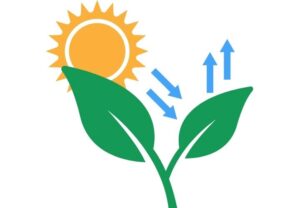The one third rule in regards to lawn mowing says that you should never remove more than one third of the leaf blade during any one lawn mowing.
Why is this so important?
 This is because all green plants manufacture their own food through photosynthesis. This process uses sunlight to convert carbon dioxide from air to sugars.
This is because all green plants manufacture their own food through photosynthesis. This process uses sunlight to convert carbon dioxide from air to sugars.
When more than a third of the leaf blade is removed during a single mowing, there is suddenly less leaf area remaining to absorb sunlight and continue the process of photosynthesis. Consequently, the grass plant produces less food for itself, resulting in a weaker plant that’s susceptible to disease and insect damage.
Cutting more than a third off the grass plant not only weakens the plant, it inhibits the growth of the roots, creating a small shallow root system. During the dry summer months, these shallow roots can become dried out, eventually killing the plant.
Grass that is allowed to grow tall will have strong, large root system below ground that can better withstand dry periods.
Research that first introduced this theory was carried out by Franklin Crider in 1955 whilst he was an employee with the US Department of Agriculture on work he undertook on pasture and forage-grasses.
Three separate studies were conducted within his experiment whereby the amount and frequency of cutting of the grass leaves (forage removal) were compared to root-growth.
His first experiment evaluated cutting leaf tissue at different intervals on cool-season turf species and Florida paspalum and Bermuda grass among his warm-season grass experiments.
The second experiment examined the effects of cutting on root-growth in the field and the last experiment examined different percentages of top-growth removed on different grasses for multiple cuttings.
Crider showed that when more than half of the forage is removed from a plant, root growth stops within the first day or two afterward and stays stopped anywhere for a further six to 18 days, with an average of 11 days, depending on the grass-type.

For real-world lawn maintenance, this means that if you were to cut more than half of the top-growth of your lawn grass, at an interval of less than 11 days, the roots would never fully recover leading to greater stresses and eventual decline.
Crider also showed in his experiments the effect that a single removal of top growth, in 10-percent increments, has on root growth.
When 40% or less of the forage is removed, 0% of the roots stop growing. However, when 50% or more of the forage is removed, an increasing percentage of the roots stop growing; and when 90% of the forage is removed, 100% of the roots stop growing.
In other words, the One Third Rule in Lawn Mowing means leaving more than a third of the leaf at any time the grass is mown during the growing season allows the roots to continue to grow. If the roots keep growing, the plant will remain healthy and perform better than under the stresses placed on it by harder mowing and slower root-growth.
Depending on the health of your grass and the weather, it may be necessary to mow your lawn twice a week during the fastest growth periods to avoid taking off more than a third of the leaf blade.
There is a definite science behind the art of Lawn Mowing, and our local Newcastle team can guide you on how to have the best looking lawn in the street!

